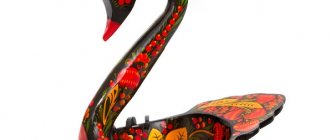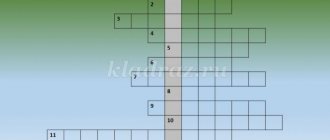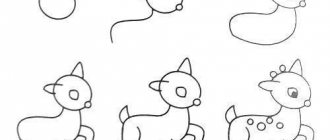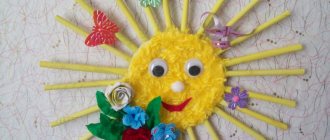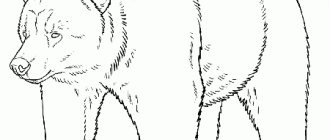Notes on drawing “Different houses have been built in the village” (children 5–7 years old)
Lyubov Petrik
Notes on drawing “Different houses have been built in the village” (children 5–7 years old)
Topic of the week: “My village”
GCD topic: “ Different houses have been built in the village ”
.
Educational field: Artistic and aesthetic development.
5-6 years: Teach children to convey the variety of rural houses : tall and long, lower and narrow, one-story. Strengthen the ability to convey the shape of parts of houses. Practice drawing with colored wax crayons.
6-7 years old: Teach children to convey in a drawing a picture of an evening village, color scheme: the houses are lighter than the night air, multi-colored lights . Strengthen the ability to draw up your plan, compositionally arrange the image on the sheet.
Form of organization: frontal, subgroup.
Preliminary work: Excursions along the streets of the village, looking at photographs, illustrations, postcards depicting houses of different types , conversation on the topic: “What kind of house do you live in?”
, reading proverbs and sayings, poems about the homeland,
constructive games .
Integration of educational areas: “Artistic and aesthetic development (music)
",
"Speech development"
, Social and communicative development",
"Physical development"
,
"Cognitive development"
.
Techniques: Surprise and game moments, creating a problem situation, showing and examining illustrations, conversation, artistic expression.
verbal: reminder, questions, individual answers from children, encouragement, lesson analysis;
visual: viewing, viewing;
gaming: didactic game, use of surprise moments, performing game actions.
practical: independent activities of children.
Demonstration material: house , crafts from “House”
.
Handouts: for children 5-6 years old, album sheets, colored wax crayons or colored pencils; for children 6-7 years old, dark paper, watercolor paints, brushes.
Receptions and techniques that are used within the framework of the theme “Fairytale houses”
A fairy-tale plot immerses a child in an amazing, mysterious world of fantasy and folk wisdom; the fates of the characters in their favorite fairy tales remain in the memory for a long time. Together with the main character, the children rescue the princess, go in search of wonderful objects, and overcome treacherous obstacles on the way to their cherished goal. Traveling through a fairy-tale country, you can visit the castle of the good fairy or the clearing of an enchanted forest in front of Baba Yaga’s hut, or escape from the wolf in the safe house of the three little pigs. Bizarre fairy-tale houses become the calling cards of every story, full-fledged heroes, without which the image of a fairy-tale episode becomes empty and lifeless, and loses the charm of magic.
Classic techniques:
- Drawing with simple and colored pencils.
- Drawing with wax crayons.
- Drawing with felt-tip pens.
- Combined method (colored pencils and watercolors, felt-tip pens or wax crayons)
- Painting with a brush using gouache - a feature of this material is its opacity, which allows you to overlap layers with a new color. Thanks to this ability, gouache is a very popular material for decorative details.
- Painting with a brush using watercolors. Children continue to be taught how to correctly put paint on a brush and mix it to obtain the desired color shade.
Children's work using classical techniques (photo)
Drawing with colored pencils
Drawing with watercolors
Drawing with colored pencils
Drawing with wax crayons
Drawing with watercolors Drawing with watercolors
Drawing with watercolors
Drawing using a combined technique (wax crayons and gouache) Drawing with watercolors Drawing with gouache
Gouache drawing
Drawing with colored pencils
Drawing with watercolors
Drawing with wax crayons Drawing with watercolors
Drawing using combined techniques (felt-tip pens and colored pencils)
Drawing with colored pencils
Unconventional techniques
- Finger painting - older preschoolers independently come up with options for using finger painting in combination with classical techniques.
- Palm impression - older preschoolers apply paint to their palm with a brush and make an impression themselves, then complete the contours and details of the object.
- Drawing with rock salt, cereals by filling a silhouette previously smeared with glue or by sprinkling the contour of an object greased with glue.
- Bleeding drawing - the contours of an object are drawn with wax crayons or a candle on a blank sheet of paper, then the top layer is applied with watercolors of one or more colors.
- Stamping is an image of objects by applying an imprint on paper using a stamp and stencil (foam rubber swab, wooden blocks made from vegetables, fruits, waste material, etc.).
- Scratching is scratching the outlines of a design onto a surface primed with wax or paint.
- Threadography is the creation of an image from whole and finely chopped threads using glue.
- Monotype is a mirror transfer of an image from a base (cellophane, plastic surface, foil) onto a sheet of paper.
Children's pictures in non-traditional techniques (photo gallery)
Drawing with cotton swabs Drawing with cereals
Drawing using the technique of nitcography
Drawing with applique elements
Drawing using palm technique
Drawing with semolina
Drawing with a candle
Drawing on wet
Drawing using monotype technique
work using grattage technique
Drawing techniques in the senior group
Older preschoolers work hard to improve their drawing techniques with pencils, crayons and felt-tip pens, since shading strengthens the muscles of the hand, develops fine motor skills and the eye, and therefore helps prepare children for writing.
- Line - can be of different configurations (straight, wavy, spiral, broken, etc.) and helps to depict a contour, conveying the outline of the shape of an object, its size and proportional relationship of parts.
- Hatching is the simplest and most effective way of rendering color and drawing the texture of an object. The stroke is not only the most popular and accessible way to depict an object, but also an excellent simulator for the development of fine motor skills and coordination of movements. Types of shading: Chaotic - strokes are laid in a free direction, then modified by additional contour drawing of the silhouette of the object.
- Vertical - dense strokes are applied in a vertical direction. Adjusting the pressure force will allow you to achieve a smooth change of various color shades.
- Diagonal - most popular for sketching the silhouette of an object or background.
- Horizontal is a rather difficult technique from the point of view of technical execution, since it requires the child to constantly change the position of his hand during the drawing process.
- Shape-building is a complex and time-consuming option for drawing the shape of an object, for example, the sun, a flower or a cloud.
GCD move:
1.Creating a problem situation:
Children go into the room.
Educator: Guys, I have important news for you. A video letter arrived at our kindergarten. Let's read it.
The children sit down . View the presentation “Letter from Dunno”
The teacher reads the letter: “Hello guys! Dunno writes to you. I like traveling very much. Today I flew in a hot air balloon and saw your small Motherland. I did not have the opportunity to land, but I saw that the houses in your village are different from the buildings in the Flower City . I really want to get acquainted with rural houses . Can you help me? I'm sure you'll come up with something. Thanks in advance. Dunno."
Educator: Guys, who is the letter from? (Children's answers)
-What is Dunno asking for? (Children's answers)
-How can we introduce Dunno to rural houses ? ( Draw houses and send to Dunno)
.
Educator: You already know that every person has a homeland. “Motherland” mean to you?
?
(Children's answers)
Educator: The place where we were born is the Motherland. We love our home, we feel very good among friends.
(“Everywhere is good, but at home it’s better ”
,
“Everyone has his own side”
,
“There is no more beautiful country in the world - our Motherland”
)
Educator: Each of us has our own home, which we love, in which our dearest and most beloved people live. We will find out which house is yours in a ball game.
Playing with the ball on the court.
Physical exercise: “Hurry up and catch the ball, and what do you call your house?”
(answer options: big, beautiful, cozy, bright, beloved, etc.)
Educator: Look, guys, how many beautiful words we came up with about home!
Examining the layout of the house.
— There are different houses and they are called differently : wooden, brick. How do you understand these names? (Wooden houses are houses built from wood , brick houses are made from bricks)
Teacher for 6-7 year old children: -Houses can also be one-story and multi-story. How do you understand these names: one-story house, multi-story house? (A one-story house consists of one floor, a multi-story house means it consists of two or more floors)
-Name the multi-storey buildings in our village . (Kindergarten, dormitory building)
Educator: And now it’s time to draw pictures for Dunno, he’s waiting for your help. Before we start drawing , let's stretch our fingers.
Finger gymnastics “HOME”
.
I want to build a house , (Hands above your head in a “house.”)
So that there is a window in it, (Hands in front of the eyes “window”)
So that the house has a door , (Palms turned towards you, closed.)
Nearby so that the pine tree grows (Fingers are spread out, hands are pulled up.)
The dog guarded the gate. (One hand is “dog.”)
It was sunny, (Cross your hands, fingers spread.)
It was raining ("Shaking" movements)
Educator: Guys, I ask everyone to choose a place to work: an easel at the table.
Children sit at tables and stand at easels.
Teacher for children 5-6 years old: (independent activity)
— Tell me, what’s on your tables? (album sheets, wax crayons and colored pencils)
.
What will you draw ? (Children's answers)
- You can start drawing .
-Guys, let's remember how to draw with wax crayons and pencils:
-When painting a drawing, you must not go beyond the contour of the drawn image .
-When painting, strokes should be applied in one direction: from top to bottom, from left to right, or obliquely.
-It is advisable to paint over the drawing without gaps.
-When painting, you need to press evenly on the pencil. If you need it brighter, press hard, if you want it lighter, press it lightly.
Or you can also draw a house like this
Well, now let’s look at the simplest drawing technique that a preschooler can draw. How to draw a house easily with your child. And so we need everything the same as in the first version for adults.
Let's start drawing according to step-by-step instructions for children:
- On a landscape sheet we draw a simple square,
- On top of the square we draw a triangle, which symbolizes the roof of our house,
- This drawing is in our projection, so we add additional walls, the house is ready,
- We connect all the sides we need for a three-dimensional house with a simple pencil,
- We draw the lines at approximately an angle of 15-20 degrees, the length of your house depends on this,
- We draw exactly the same straight line from the roof,
- This is how we got the house in projection,
- We add windows, doors, pipes, ebbs and other elements necessary for a realistic drawing,
- The drawing can be decorated, or left in a simple pencil,
- If desired, you can complete the composition: add trees, flowers, a fence, people, animals. In this case, the yard will be a full cup. It would be nice if your child drew himself and his parents.
At the same time, make sure that your child combines colors correctly. And don’t forget to pay attention to the use of colors in your child’s drawings. This will help monitor your child's psychological state.
Drawing classes help in the development of your child, both psychological and mental development.
Constant exercise will only improve your communication and the child’s condition.


